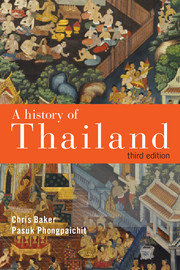Book contents
- Frontmatter
- Contents
- Illustrations
- Preface
- Abbreviations
- Glossary
- Chronology
- 1 Before Bangkok
- 2 The old order in transition, 1760s to 1860s
- 3 Reforms, 1850s to 1910s
- 4 Peasants, merchants, and officials, 1870s to 1930s
- 5 Nationalisms, 1910s to 1940s
- 6 The American era and development, 1940s to 1960s
- 7 Ideologies, 1940s to 1970s
- 8 Globalization and mass society, 1970s onwards
- 9 A political society, 1970s onwards
- Postscript: The strong state and the well-being of the people
- Notes
- Reigns and prime ministers
- Glossary of names
- Readings
- Index
8 - Globalization and mass society, 1970s onwards
Published online by Cambridge University Press: 05 August 2014
- Frontmatter
- Contents
- Illustrations
- Preface
- Abbreviations
- Glossary
- Chronology
- 1 Before Bangkok
- 2 The old order in transition, 1760s to 1860s
- 3 Reforms, 1850s to 1910s
- 4 Peasants, merchants, and officials, 1870s to 1930s
- 5 Nationalisms, 1910s to 1940s
- 6 The American era and development, 1940s to 1960s
- 7 Ideologies, 1940s to 1970s
- 8 Globalization and mass society, 1970s onwards
- 9 A political society, 1970s onwards
- Postscript: The strong state and the well-being of the people
- Notes
- Reigns and prime ministers
- Glossary of names
- Readings
- Index
Summary
The Cold War in Asia eased after the US departure from Indochina. The USA remained Thailand’s military patron, but at a much greater distance. Thailand’s orientation to a liberal market economy, established in the American era, strengthened as the socialist alternative declined on a world scale. After an initial period of economic and political adjustment to the US departure, Thailand caught the tail of an Asia-wide boom led by Japan and the East Asian ‘Tiger’ economies. The liberalization of first trade and then finance accelerated the pace of industrialization and urbanization, and incorporated Thailand more firmly within a global economy. The close of the Cold War also transformed neighbouring countries from enemy territory into economic hinterland – as markets, and as sources of human and natural resources. In the late 1980s, China emerged from its four decades of partial eclipse, and again became a major factor in Thailand’s economy and position in the world.
The pace of economic transformation quickened over the last quarter of the 20th century. The balance of economy and society shifted decisively from rural to urban, and from parochial to open and globalized. The peasantry declined steeply as an element in the national economy, more moderately as a factor in the demography, and very markedly in the national culture. The rural remnant became an increasingly marginalized and truculent part of a society whose dynamism was decidedly urban.
- Type
- Chapter
- Information
- A History of Thailand , pp. 199 - 234Publisher: Cambridge University PressPrint publication year: 2014



